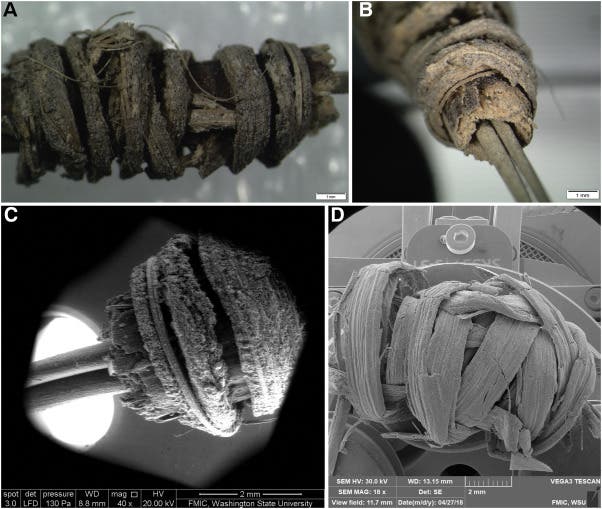Archaeologists from the Washington State University (WSU) report finding the oldest tattooing tool in western North America.

Yucca leaf strips on the Turkey Pen tattoo artifact and on the replica.
Image credits Andrew Gillreath-Brown et al., 2019, JASR.
The Ancestral Pueblo people living in Utah around 2,000 years ago were big on tattoos, new research suggests. A team from the WSU led by Andrew Gillreath-Brown, an anthropology Ph.D. candidate, discovered a pen-sized instrument used to apply tattoos — the tool has been sitting in storage at the WSU Museum of Anthropology for 40 years.
Ancient ouch
Andrew found the item by chance while reviewing archaeological materials from the Turkey Pen site in southeastern Utah. This tool was made around 2,000 years ago by the Ancestral Pueblo people of the Basketmaker II period in what is now southeastern Utah, they report, pushing back the history of tattooing in western North America by more than a millennium.
“Tattooing by prehistoric people in the Southwest is not talked about much because there has not ever been any direct evidence to substantiate it,” says Gillreath-Brown.
“This tattoo tool provides us information about past Southwestern culture we did not know before.”
Tattooing is an art, a form of cultural expression, and practical skill with ancient roots that many people worldwide enjoy even today. However, we don’t know a lot about how, when, and where this practice began. Its history is especially-muddy in areas like the southwestern US, the team adds, where written accounts are lacking and no tattoos have been preserved on human remains.
In such cases, researchers rely almost fully on ancient artwork for depictions of tattoos and the implements used to create them. As far as archaeological evidence goes, we’ve found bundled and hafted (or handled) cactus spine tattoo tools in Arizona and New Mexico that were used to apply tattoos sometime between AD 1100-1280.
The tool Gillreath-Brown found was very similar in structure to these previously-uncovered tattooing tools. It consists of a 3.5 inch (roughly 9 cm) wooden handle — made from skunkbush wood — and two parallel cactus spines stained black at their tips.
“When I first pulled it out of the museum box and realized what it might have been I got really excited,” he said.
“The residue staining from tattoo pigments on the tip was what immediately piqued my interest as being possibly a tattoo tool.”
Scanning electron microscopy and X-ray fluorescence analysis showed that the crystalline structure of the black pigment showed that the inks likely contained carbon — a common element in body and tattoo paints around the world. Gillreath-Brown also created a few test tattoos using a replica of the tool on pig skin using ink “made using wood charcoal, ground using a mortar and pestle and mixed with water to a slurry-like consistency.” The tool performed quite well, he reports, inserting pigment deep enough into the skin to create tattoos (about 2 mm deep, corresponding to the epidermis).
“[The discovery] has a great significance for understanding how people managed relationships and how status may have been marked on people in the past during a time when population densities were increasing in the Southwest,” Gillreath-Brown reports.
The paper “Redefining the age of tattooing in western North America: A 2000-year-old artifact from Utah” has been published in the Journal of Archaeological Science: Reports.









